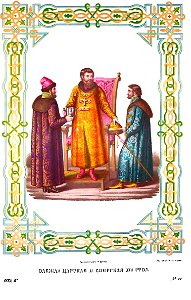Antiquities of the russian country, 1846-1853. Volume 4. Illustrator — ru: solntsev, fyodor grigorievich. Tsarist and boyar clothing of the 17th century. Baron meyerberg, who served as ambassador from the german emperor to tsar alexei mikhailovich, described in his travels his reception at the russian court. True photographs from the drawings for his description, kept in the dresden royal library, were published by mr. Adelung in st. Petersburg in 1827 at the expense of count n. P. Rumyantsev. Here, academician solntsev reproduces one of these drawings, representing the extraordinary private audience of the ambassador on april 24, 1662. The tsar is depicted in his royal utensils and at the very moment when he is preparing to drink to the health of his sovereign brother, caesar leopold. Out of respect for his name, he rose from his royal chair and, taking off his hat, with his left hand he hands it to the steward prince mikhail dolgorukov standing before him, and with his right he accepts a toast from the steward prince ivan alekseevich vorotynsky. At the private audience, the tsar was dressed in the second or third outfit; he is wearing a ferezei made of gold fabrics, lined with fur, with a fur necklace and three buttonholes; he has a cross on his chest. The fur coats of the stewards standing before him have a turn-down collar, and an undercoat with a trump. The throne was as magnificent as the chair with a low footrest was at the private one. To give an idea of the tsar's outfit at the first audience with the imperial ambassadors on may 20, 1661, we will present here for comparison two descriptions: one placed in petreius, and the other from the exit books. “the grand duke,” notes the swedish ambassador, “had on his head a small sable cap, on which was placed a gold crown, closed crosswise at the top and decorated with many precious stones, his dress was of gold brocade, lined with scarlet velvet; it was all covered with a rich stripe of large pearls, like tree leaves. Around the entire dress, as well as on the sleeves, there was a border a quarter of an elbow wide, completely studded with the most beautiful pearls and precious stones. Over the caftan, he wore around his neck a wide, rich collar of the largest pearls and precious stones, hanging below the shoulders. On his chest was a gold cross a quarter of an elbow long and two fingers thick; on all his fingers he had many large rings and signet rings. His boots were strung with pearls. ” the tsar's attire at this same audience is described in the following way in the exit books: "the tsar was wearing a large treasury outfit: a cross, a diadem of the second order, a chain of gold rivets, the tsar's cloak, velvet of amber gold loops, the tsar's caftan, a vinnitsa lace of gold on green earth; braid, the tsar's cap of the second order with an emerald, an apple with a stand, the tsar's scepter. ". Date: between 1846 and 1853.
Loading...
